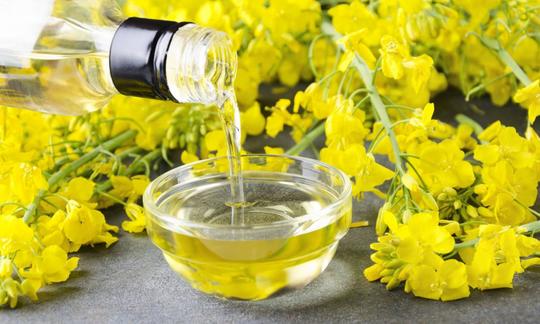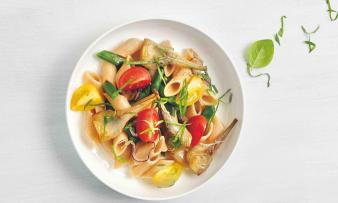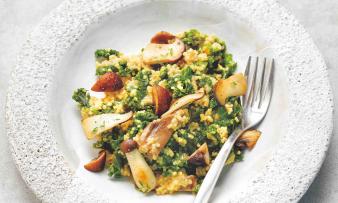Table of contents
Rapeseed oil is pressed from the seeds of the rapeseed ( Brassica napus). Refined rapeseed oil is suitable for heating, but has hardly any aroma. In addition, the refining process causes it to lose valuable vitamins and a certain amount of polyunsaturated fatty acids (such as omega-3 fatty acids), which are usually present in higher concentrations in cold-pressed rapeseed oil.
Use in the kitchen:
Refined rapeseed oil is light yellow and almost tasteless, which is why it can be used in a wide variety of ways in the kitchen. While native, cold-pressed rapeseed oil decomposes at 140 °C, refined rapeseed oil is clearly more heat-resistant. The figures here vary between 180 1 and 200 °C. 2 Although it remains stable at higher temperatures, it should be heated slowly to the desired temperature when frying, baking, deep-frying, cooking and steaming - and not exceed the temperatures mentioned here for each type.
Rapeseed oil can also be used to produce margarine industrially. This spread usually consists of 90% vegetable fats, but in the end margarine mainly contains hydrogenated fats and trans fatty acids are created.
Thanks to special breeding, "unrefined" rapeseed oil, so-called high oleic rapeseed oil (HOLL rapeseed oil, high oleic low linolenic or HO oil), can also be heated to high temperatures. The plant contains up to 90% oleic acid, which greatly increases the smoke point of the oil. This is because the monounsaturated fatty acid (oleic acid) is much more heat-resistant than the polyunsaturated representatives (ALA etc.), which are generally more sensitive to heat, light and air.
Special steam treatments disable fat-splitting enzymes, but hardly change the fat components. Although temperatures of up to 120 °C can be reached, it can be described as cold-pressed oil. The smoke point of high-oleic oils is around 210 °C. 3 In addition, natural coloring and flavorings are retained and no trans fatty acids are formed.
Some vegetable fats such as soybean oil, coconut oil or peanut oil can even be heated to over 230 °C. 4 However, these are too rich in saturated fatty acids and should therefore be avoided.
However, if smoke develops, all oil must be thrown away without exception. Old oils must be disposed of properly. They must not be allowed to enter the sewage system (drain or toilet), otherwise they will stick and clog the pipes. There are usually collection points or containers where you can dispose of used oil. In some countries, you can put it in the general waste if it is tightly closed. You should ask your local waste disposal office/recycling center about this.
Recipe for vegan apple and lentil soup:
Ingredients: 2 apples, 1 red onion, 1 piece of ginger, 4 tablespoons rapeseed oil, 300 g red lentils, 800 ml vegetable stock, 200 ml apple juice, ½ teaspoon cumin (ground), ½ teaspoon coriander (ground), sea salt,pepper.
Preparation: Peel the ginger and onion and chop finely. Core the apples, peel if necessary and dice finely. Heat the oil in a pan, sauté the onion, ginger and apples for a few minutes. Add the lentils and sauté briefly again, then deglaze with the vegetable stock and simmer for 15 minutes. When the lentils are soft, you can add the apple juice and puree everything with a hand blender. Then season the soup and add salt and pepper to taste.
| Not only vegans or vegetarians should read this: Vegans often eat unhealthily. Avoidable nutritional errors. |
Shopping - where to buy?
Refined rapeseed oil is available in all supermarket chains such as Coop, Migros, Denner, Volg, Spar, Aldi, Lidl, Rewe, Edeka, Hofer etc. Organic rapeseed oil is sometimes also available in conventional supermarkets and actually always in the standard range in organic supermarkets, organic shops, health food stores and drugstores. These organic oils are almost always cold-pressed and, according to organic regulations, must not be chemically refined.
Cold-pressed oils (laws, raw food)
In Switzerland, oil is referred to as cold-pressed oil if the oilseed was not heated, the pressing temperature did not exceed 50 °C and no problematic post-treatment took place.
According to the Federal Department of Home Affairs ( FDHA), an edible oil is considered cold-pressed (or may be described with synonyms such as (extra) virgin, unrefined, cold-pressed or natural) if it has been obtained by pressing or centrifuging from previously unheated raw materials, the temperature during pressing did not exceed 50 °C and it has not been subjected to refining, i.e. no neutralisation, no treatment with adsorbents, bleaching earth or steaming.
An oil may be described as “gently steamed” if the refining process was limited to steaming and the temperature did not exceed 130 °C. 15
In the EU and the USA, there does not appear to be a generally applicable temperature limit for cold-pressed oils. For example, the guidelines for edible fats and oils of the Federal Ministry of Food and Agriculture (D) are similar to the EDI regulation, but they do not specify a permissible maximum temperature for general cold pressing - since they only apply to products whose labelling and composition are not conclusively defined by law (i.e. not for olive oil, cocoa butter, milk fats, spreadable fats, for example). 16
On the other hand, both the EU directives and the EDI regulation on foods of plant origin, mushrooms and table salt (and their amendments) provide for special rules for the labelling of olive oils. 17,18
These are selective marketing rules in which the term raw food is not defined. "Raw food" and "raw" are therefore not state-protected terms (as is the case with the term "organic"), which leaves a lot of room for interpretation. Although it is agreed that with purely mechanical cold pressing, the pressing temperatures generally do not exceed 40 °C, one should not naively assume that edible oils are of raw food quality. There is a suspicion that the measuring method used does not indicate the temperature in the press cylinder (where the heat is highest), but only the outlet temperature in the oil hose. With water-cooled olive oil presses (so-called "water-cooled 37°" oil presses), one probably cannot even say with certainty what the exact temperature is inside the press cylinder, because the entire press cylinder is surrounded by cooling sleeves.
In addition, the pressing pressure and speed as well as the moisture content of the oilseed affect the pressing temperature. If, for example, the moisture content is too low, the temperature rises during pressing and it is difficult to stay even below the maximum limit of 50 °C. 19
There are cold-pressed and then physically refined rapeseed oils from manufacturers who produce baby food, for example. They promise that this will avoid any contamination. 5
Storage:
Oils should always be stored in a cool, dark place. Sunlight can lead to a bitter taste, which is why oils are usually found in dark bottles. We recommend pouring the contents of transparent bottles into opaque containers. Refined rapeseed oil lasts a little longer when opened, but it should still be used within 1-2 months. Unopened bottles can be kept for up to a year if stored optimally.
Ingredients - nutritional value - calories:
The ingredients we have compiled for this product are based on information provided by various commercial representatives. The products are subject to large fluctuations in quality and nutrient composition depending on the manufacturer, which means that certain extreme values cannot be taken into account. The weight per liter must also be taken into account: How heavy is 1 liter of rapeseed oil? The temperature and type of oil are important here. For 1 kg of rapeseed oil you need around 1.085 liters with a density of around 0.92 kg/l (specific weight).
Refined rapeseed oil consists of approximately 100% fat, of which 55-65% are monounsaturated fatty acids, 25-30% are polyunsaturated fatty acids and approximately 6-8% are saturated fatty acids. It may also contain a small amount of table salt (approx. 15-20 mg/100g).
The proportion of alpha-linolenic acid (an essential omega-3 fatty acid) in refined rapeseed oil is around 6-8 g/100g. Linoleic acid (omega-6 fatty acid) is 19-21 g/100g. From a nutritional point of view, the ratio of around 3:1 (LA:ALA) is very good, significantly better than that of extra virgin olive oil, with a ratio of 11.6:1. According to the Federal Nutrition Commission ( EEK), the ratio should not exceed 5:1 per day.
Erucic acid (omega-9 fatty acid) is hardly found in rapeseed anymore. Through breeding, it has been possible to remove not only the erucic acid, which is harmful to health, but also the sharp-tasting mustard oil glycosides (glucosinolates) from the rapeseed varieties used. Modern rapeseed varieties are therefore called "double zero" or "00 varieties". 6
You can find all the ingredients, the coverage of the daily requirement and comparison values with other ingredients in our nutrient tables. In the article Nutrients explained you will get a detailed insight into the topic.
Health aspects - effects:
Even if the fatty acid ratio is relatively similar in cold-pressed and refined rapeseed oil, there are differences in the composition of the various fatty acids - for example, the content of the omega-3 fatty acid α-linolenic acid. Through refining, rapeseed oil loses vitamins and other fatty substances (carotenoids, etc.) as well as secondary plant substances. Therefore, the color and taste also change very significantly.
The healthy, polyunsaturated and monounsaturated fatty acids can lower the LDL cholesterol level (low density lipoprotein) in the blood. They reduce the risk of arteriosclerosis and have a positive effect on our cardiovascular system. 6
The hormone-like substances EPA eicosapentaenoic acid and DHA docosahexaenoic acid, which are formed from omega-3 fatty acids, have antithrombotic, anti-inflammatory and bronchodilator and vasodilator effects. 7
Dangers - intolerances - side effects:
Rapeseed oil is said to lead to dramatic weight gain when consumed regularly, at least in animal experiments, and also to have a negative effect on memory performance. Although it is not directly responsible for Alzheimer's, researchers found an increased number of peptides that are suspected of promoting Alzheimer's. 8
Polyunsaturated fatty acids can also have a negative impact on health. If consumed in excess, potentially harmful oxidation products can form. These oxidation products can be neutralized with natural antioxidants from fresh vegetables and fruit. Vitamin E plays an important role in neutralizing lipid peroxide radicals. 6,9
All refined (purified) vegetable oils contain 3-MCPD fatty acid esters, which the International Agency for Research on Cancer ( IARC) classified as a "possible human carcinogen" in 2011. 10
Trans fats are not only created when fat is hardened, but can also be created when food is heated for a long time and at high temperatures (e.g. deep-frying). Trans fatty acids increase the (bad) LDL cholesterol in the blood and lower the (good) HDL cholesterol. In addition, increased triglyceride levels (dyslipoproteinemia) can promote cardiovascular disease. 11
Basically, a conscious use of cooking fats is important for health. If possible, oil should be reduced to a minimum, because it is, like white sugar, an unnatural concentrate. Some prominent doctors in the USA are calling for a conscious diet without oil. There are enough seeds, nuts and high-fat fruits (eg avocado) that cover the need for important fatty acids.
Occurrence - Origin:
The origin of rapeseed as a cultivated plant is thought to be in the Mediterranean region, where it arose from a natural cross between cabbage and turnip rape. Oil has been pressed from the seeds since the Middle Ages. 12
Cultivation - Harvest:
When cultivating, a distinction is made between summer and winter rapeseed. Winter rapeseed is only frost-hardy to a limited extent, which is why it is sown in mid-August. Summer rapeseed is less important. Breeding has made it possible to almost eliminate the erucic acid content in edible rapeseed. In the chemical-technical field, however, euruic acid is desirable and the proportion is up to 55%.
Pressing and refining:
To press rapeseed oil, the rapeseed must first be prepared. This means that the seeds are cleaned and chopped. The larger surface area this creates results in a better oil yield. It is also possible to heat the chopped seeds in a heating pan. The oil contained in the seeds has a thinner consistency and is easier to press out of the seeds.
The seeds then go to an oil mill, where the oil is mechanically pressed out. The cold pressing process involves pressing without heat, just using pressure or friction, so all of the ingredients remain intact. The hot pressing process involves temperatures of over 100 °C.
The remaining press cake still contains 6-8% oil, which is why it is chopped again and deoiled in the extractor until it has a residual oil content of 1-2%. Solvents are often used here. Now all that remains is rapeseed meal (extraction meal), which is suitable for animal feed.
In the final step, odors, flavors and colors are removed. Modern, large-scale refining plants guarantee gentle refining that preserves the valuable ingredients.
Chemical refining is common, and according to Wikipedia, the following steps take place: delecithination, degumming, neutralization, bleaching, possibly winterization and deodorization (steaming). Deodorization breaks down unwanted fatty substances, removes flavors and ensures heat stability. However, this process requires temperatures of 130-220 °C.
Physical refining uses increasing temperatures (e.g. for deacidification) instead of chemical agents. This process is said to be much gentler on the polyphenols contained and less harmful to the environment. It is now being used more and more frequently not only in the production of tropical fats, but also in the production of domestic cooking oils (organic oils). 13
Refined oils are also known as RDBW (refined, deodorized, bleached and winterized).
The manufacturing process for rapeseed oil is not nearly as clearly declared as for olive oil, for example. If it is declared at all, it will say "cold pressed" on the bottle. As a consumer, you do not know whether it is high-oleic rapeseed or whether the oil has been refined using a chemical or physical process.
Animal protection - species protection - animal welfare:
The rapeseed plant, which blooms in May, is an important source of nectar for honey bees. Many other insects also find shelter and food there. Nectar is the food that the bees bring in (nectar, pollen, honeydew). The pollen and nectar values of rapeseed are very high. Each of the numerous yellow flowers produces nectar with a sugar content of 0.4 to 2.1 mg within 24 hours. 14 Unfortunately, deer also die if they lose their herds and have not yet learned to do without rapeseed plants in large quantities.
General information:
Rapeseed oil is usually obtained from the seeds of the rapeseed plant ( Brassica napus subsp. napus), sometimes also from the seeds of the closely related rapeseed ( Brassica rapa subsp. oleifera). 12 Although rapeseed only "lost" its toxins through breeding in the 1970s and 1980s, it was common in certain areas to eat young leaves as cut cabbage before then. The stems of some varieties are also used as vegetables in Asian and African cuisine. 20
Alternative names:
Rapeseed oil is also sometimes known as turnip oil, colza oil, cabbage seed oil or canola. In English, colza oil or colza is known as the rapeseed oil with increased erucic acid, it is mainly used in industry. Canola oil or canola contains less than 2% erucic acid, it can be used as a cooking oil in addition to being used for biodiesel.
The English term canola is primarily used in North America and Australia to refer to today's cultivated rapeseed. It can also specifically refer to (partially genetically modified) rapeseed from the USA, Canada and Australia. This is basically comparable to the European double-zero rapeseed (00 rapeseed, without genetic modifications).
The plant is also known in German as Reps or Lewat. In English, the common rapeseed plant is mainly called rapeseed, but it is also known as rape, oilseed rape, coleseed or canola.
Keywords for use:
Rapeseed oil was originally not intended for use as a food product because the erucic acid and bitter substances content was far too high for human consumption. In the past, it was only used as lamp oil, lubricant and as a raw material for soap production. 12
Today, rapeseed oil is also used as biofuel and in industry. Rapeseed is found in biodiesel and also in crop protection products, animal feed, motor and lubricating oils, solvents, varnishes and paints. The pharmaceutical industry also uses rapeseed oil to produce medicinal ointments and cosmetic formulations.
Literature - Sources:
Bibliography - 20 Sources
| 1. | Srf.ch Rapsöl - Verkanntes einheimisches Gold. 2015. |
| 2. | Öl-kontor.de Übersicht der Rauchpunkte & Brennwerte von Öl. |
| 3. | Lämmerhirt N. UGB-Forum Unabhängige Gesundheitsberatung. Bratöle: Vorsicht: heiss und fettig! 4/01. |
| 4. | Utopia.de Speiseöle und ihr Rauchpunkt: welches Öl für welchen Zweck? 2017. |
| 5. | Hipp-fachkreise.de 100 % Bio Rapsöl. |
| 6. | Aid Infodienst (Hrsg.). Speisefette. 17. Auflage. Druckerei Lokay e.K. Reinheim: Bonn. 2014. |
| 7. | Leitzmann C, Müller C et al. Ernährung in Prävention und Therapie. 3. Auflage. Hippokrates Verlag: Stuttgart. 2009. |
| 8. | Lauretti E, Praticò D. Effect of canola oil consumption on memory, synapse and neuropathology in the triple transgenic mouse model of Alzheimer's disease. Scientific Reports. 2017;7. |
| 9. | Biesalski HK, Grimm P et al. Taschenatlas Ernährung. 6. Auflage. Georg Thieme Verlag: Stuttgart. 2015. |
| 10. | BfR Bundesinstitut für Risikobewertung. Fragen und Antworten zur Kontamination von Lebensmitteln mit 3-MCPD-, 2-MCPD- und Glycidyl-Fettsäureestern. 2018. |
| 11. | DGE Deutsche Gesellschaft für Ernährung. Evidenzbasierende Leitlinie: Fettkonsum und Prävention ausgewählter ernährungsmitbedingter Krankheiten. 2. Version. 2015. |
| 12. | Gülzow. FNR Fachagentur Nachwachsende Rohstoffe e.V. Pflanzen für die Industrie. 4. Auflage. 2005. |
| 13. | Innovations-report.de Hochwertiges Rapsöl nach physikalischer Raffination. 2006. |
| 14. | Lipp J, Vorwohl G. Handbuch der Bienenkunde. Der Honig. 3. Auflage. Eugen Ulmer Verlag: Stuttgart. 1994. |
| 15. | Verordnung des EDI über Speiseöl, Speisefett und daraus hergestellte Erzeugnisse vom 23. November 2005 (Stand am 1. April 2008), Art. 3a und 3b. |
| 16. | bmel.de Leitsätze für Speisefette und Speiseöle. Neufassung vom 02.07.2020 (BAnz AT 18.08.2020 B3, GMBl 2020 S. 530). |
| 17. | BMEL Bundesministerium für Ernährung und Landwirtschaft. Amtsblatt der Europäischen Union. Durchführungsverordnung (EU) Nr. 29/2012 der Kommission vom 13. Januar 2012 mit Vermarktungsvorschriften für Olivenöl. Artikel 5 a) und b). 14.1.2012. |
| 18. | EDI Eidgenössisches Departement des Innern. Verordnung des EDI über Lebensmittel pflanzlicher Herkunft, Pilze und Speisesalz (VLpH). Änderung vom 8. Dezember 2023. Inkrafttreten: 1. Februar 2024. |
| 19. | Schaufler D. Oilseed Fact Sheet: Oilseed Presses. Dept. of Agricultural and Biological Engineering, Penn State College of Agricultural Sciences. |
| 20. | K. Ondereschka et al.: Gehäufte Rehwildverluste nach Aufnahme von 00-Raps. In: Zeitschrift für Jagdwissenschaft. Volume 33, Number 3, 191–205. |










Comments